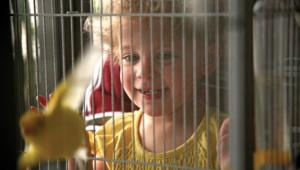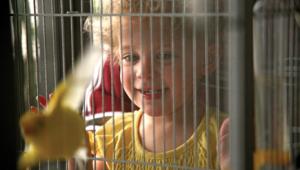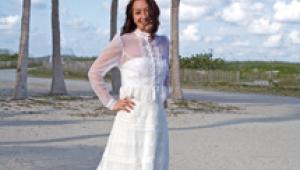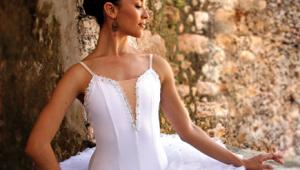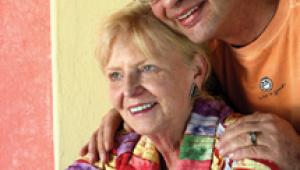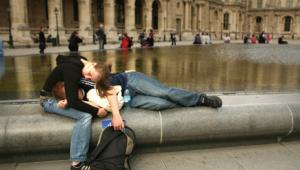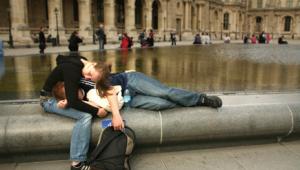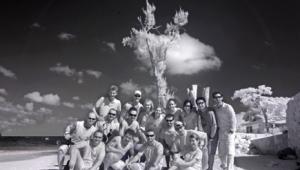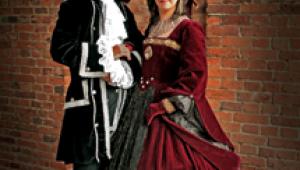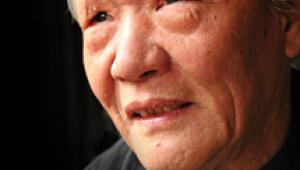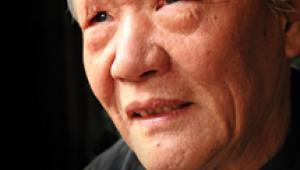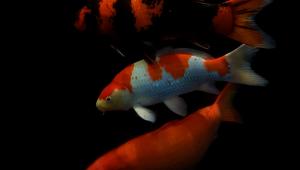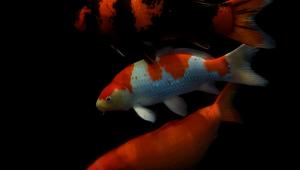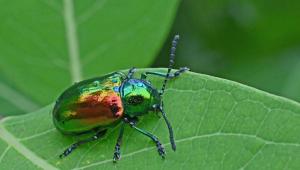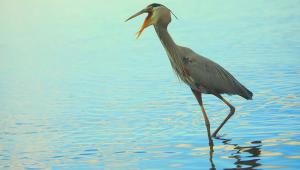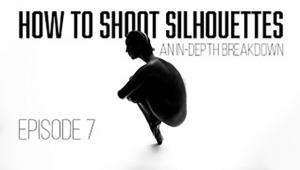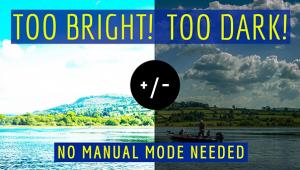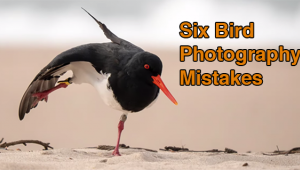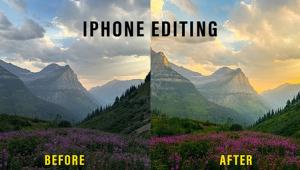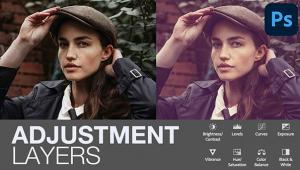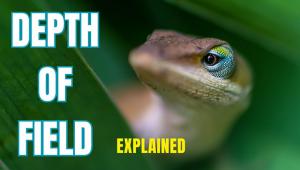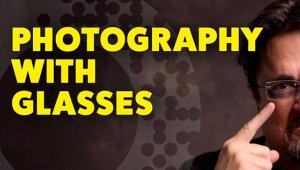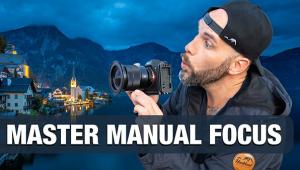Master Class
Who Teaches The Teacher? Some Lessons Learned From Others In The Craft
Photos © 2004, Monte Zucker, All Rights Reserved
I 've often heard it said that the teacher learns from his students.
Such has certainly been the case for me. My Photoshop guru, Eddie Tapp, was
in my classes years ago when he was first becoming a photographer in Dallas.
Now, I study with him every time that I get a chance to attend one of his five-day
classes or to watch him even for a few moments at a convention appearance. It's
the only way in which I can try to stay abreast of some of the techniques that
he has developed with each successive edition of Photoshop. I use at least a
few of the techniques that he has taught me on almost every single one of my
photographs.
Taking at least one or two classes a year myself is one of the things that keeps
me excited professionally and constantly growing as a photographer. I select
my teachers by observing the images that they're producing and by learning
from others if these photographers are also good teachers.
Such was the case recently when I took a class with Miami-based Robert Lino
hosted in Merida, Mexico, by Michele Gauger, who hosts several classes a year
in Mexico, calling them the Yucatan Experience. I, too, am a teacher for one
of them annually.
Both Gauger and Lino had studied with me in the past. Now, I was learning from
them. And learn I did. Each day I marveled at what Lino was able to accomplish
with the simplest of equipment. As a matter of fact he was using no equipment
other than his Canon digital camera. No reflectors. No flashes. Nothing! That
interested me, since I use so many accessories to create my photographs. I wanted
to see how he did it.
The Infrared Idea
On one of our morning expeditions we went to some Mayan ruins for a sunrise
shoot. Posing was the main reason for my wanting to study with Lino. I loved
what he was doing, especially since it was so different from my style. One of
the first things he did that morning was to pose our female model on a corner
of one of the ancient ruins.
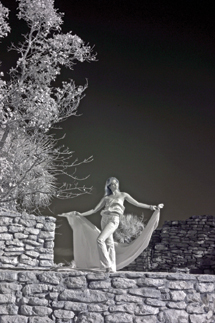
One of Lino's specialties is the use of fabrics as a prop.
A typical piece is about 10-12 ft in length. The wind was blowing pretty hard
that morning, so he gave our model a piece of white silk fabric to hold out
as part of her "costume." The wind filled her "sails."
The fabric bellowed out dramatically. His posing of her was handled exquisitely.
He started her pose at the feet, pointing her forward "show foot"
toward the camera, placing her weight totally on the back foot and bending her
front leg in an exaggerated curve. He followed it through by pushing her forward
hip toward the back, lowering her front shoulder and tipping her head toward
her higher back shoulder. I had always turned and tipped her head to her higher
front shoulder.
He completed the pose by bringing out both of her elbows and creating space
between her arms and body. The "S-Curve" that this created was incredibly
beautiful. I loved the way that her body looked! That's why I wanted to
study with him.
I know that it must be difficult to understand what I'm explaining here,
but by studying the accompanying image you should be able to see exactly what
I'm describing.
Lino was almost embarrassed to show me how different his style was from mine.
I assured him, however, that I was loving every single thing that he was doing.
Plus, that was exactly why I wanted to study with him--to see what he was
doing, to learn how we was doing it, and to adapt some of his techniques as
an add-on to what I was already doing.
As he began taking his pictures, Lino suggested that we photograph at the same
time. All the photographers participating in the class were, of course, shooting
digitally, but I was the only photographer who also had a digital camera that
was adapted solely for creating infrared images. (For more information on having
a camera dedicated to infrared digital imaging e-mail irguy@infrared.com.)
I knew from past experience that infrared worked marvels when photographing
sunlit green trees against the sky, but I had never before photographed portraits
with infrared. Wow, was I in for a pleasant surprise! I kept the picture simple,
composing the photograph instinctively without having to think of her placement
in the photograph. I used a 28-135mm IS lens on an infrared-adapted Canon EOS
D60.
"Attitude" Can Be The Key
One of Lino's incredible talents is directing his models for
mood, expression, and attitude. The photographers in his class all positioned
themselves for what they felt would be the best camera position as Lino spoke
to the models and "worked them" as only he can do. I set myself
up for a 2/3 camera position of their faces and really lucked out with this
picture--one of my favorites of the week.
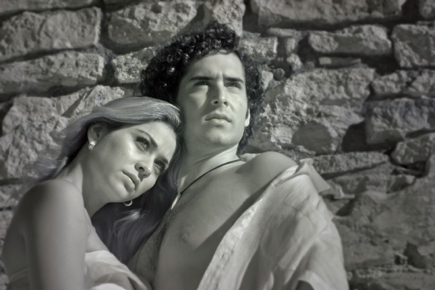
Wow--I never realized how beautiful the skin tones could be when shooting
infrared! All I had to do in Photoshop was to position some subtle catchlights
in their eyes. Then, I toned down the background by going to Image/ Adjust/Curves
in Photoshop, bringing down the highlight side to midway and erasing the areas
that I wanted left as-is. I also softened the stones behind them slightly using
Gaussian Blur on a separate layer and erasing the blur from their faces.
Trees, Sky, And Clouds--The Perfect Ingredients
Back at The Reef, our home away from home, I couldn't resist making more
pictures.

Talk about a fantastic vacation resort, The Reef in Yucatan, Mexico, was a picture
post card--happening any and every way you turned. The trick here was to
simplify and focus in on elements that would form pleasing compositions. This
bridge and palm tree, for instance, created a graphic design from a low angle
that showed beautifully against the sky.
I made this photograph on the first day of class when Lino's arrival to
Merida was delayed. I became the instructor-for-a-day and showed how I photograph
all day long in direct sunlight as well as in shade. When making this photograph
I pointed out how I positioned myself and my subjects using the direct sun as
my main light, keeping as much as possible the light crossing my subjects at
a 45Þ angle.
I was shooting with Canon's EOS 20D for everything other than the infrared.
My photographs are captured on a new High-Speed 2GB Delkin memory card. I never
ran out of "film!" The color was unbelievably gorgeous and the speed
of the card writing the image after each exposure was incredible.
In the past few years I became very aware that the automatic white balance on
cameras was less than ideal. I now hang around my neck an ExpoDisc, a simple,
easy to use method for custom white balancing in a matter of seconds.
